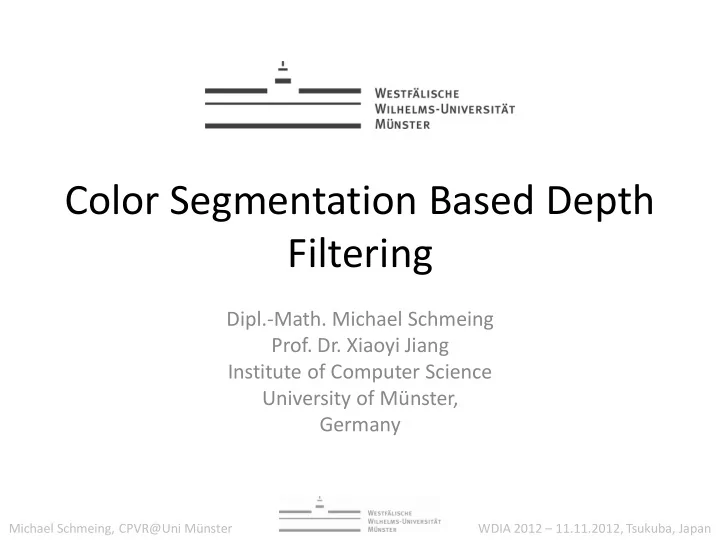

Color Segmentation Based Depth Filtering Dipl.-Math. Michael Schmeing Prof. Dr. Xiaoyi Jiang Institute of Computer Science University of Münster, Germany Michael Schmeing, CPVR@Uni Münster WDIA 2012 – 11.11.2012, Tsukuba, Japan
Overview • Depth Filtering • Our Approach • Results – Qualitative – Quantitative analysis method • Conclusion Michael Schmeing, CPVR@Uni Münster WDIA 2012 – 11.11.2012, Tsukuba, Japan
Depth Filtering • Depth generation methods: – Active • Laser Scanner • ToF • Structured Light – Passive • Depth from stereo • Depth from motion • Depth from X • There are no perfect depth maps Michael Schmeing, CPVR@Uni Münster WDIA 2012 – 11.11.2012, Tsukuba, Japan
Occlusions Imperfect edges Example depth map • Kinect (structured light camera) Michael Schmeing, CPVR@Uni Münster WDIA 2012 – 11.11.2012, Tsukuba, Japan
OUR APPROACH Michael Schmeing, CPVR@Uni Münster WDIA 2012 – 11.11.2012, Tsukuba, Japan
Our Approach • Focuses on edge restoration • Takes edge information of associated color stream • Workflow: 1. Occlusion Filling 2. Segmentation of color stream 3. Computation of representative depth map 4. Edge restoration 5. Post processing Michael Schmeing, CPVR@Uni Münster WDIA 2012 – 11.11.2012, Tsukuba, Japan
Occlusion Filling • Normalized convolution Michael Schmeing, CPVR@Uni Münster WDIA 2012 – 11.11.2012, Tsukuba, Japan
Color Segmentation • Edge information is taken from an oversegmentation (superpixel segmentation) • We take Watershed segmentation because – Fast – Compact segments – Segments of approx. the same size (except thin “edge segments”) • Color Segmentation: – Preprocessing of color stream (bilateral filter because of noise) – Apply Watershed – Cluster Splitting Michael Schmeing, CPVR@Uni Münster WDIA 2012 – 11.11.2012, Tsukuba, Japan
Watershed Segmentation • Idea of Watershed: – Interpret Grayscale image as relief – Place water sources on it – Flood relief and draw borders where lakes meet – Apply Bilateral Filter prior to reduce noise Michael Schmeing, CPVR@Uni Münster WDIA 2012 – 11.11.2012, Tsukuba, Japan
Watershed Color Segmentation Michael Schmeing, CPVR@Uni Münster WDIA 2012 – 11.11.2012, Tsukuba, Japan
Projected Color Segmentation in Depth Michael Schmeing, CPVR@Uni Münster WDIA 2012 – 11.11.2012, Tsukuba, Japan
Representative Depth Map • Compute a representative depth value for each segment Michael Schmeing, CPVR@Uni Münster WDIA 2012 – 11.11.2012, Tsukuba, Japan
Edge Restoration • Use representative depth map to enhance edges: • Outliers are corrected by depth values of the representative depth map • Postprocessing: Bilateral Filter Michael Schmeing, CPVR@Uni Münster WDIA 2012 – 11.11.2012, Tsukuba, Japan
RESULTS Michael Schmeing, CPVR@Uni Münster WDIA 2012 – 11.11.2012, Tsukuba, Japan
Original Depth Map Michael Schmeing, CPVR@Uni Münster WDIA 2012 – 11.11.2012, Tsukuba, Japan
Normalized Convolution [9] Michael Schmeing, CPVR@Uni Münster WDIA 2012 – 11.11.2012, Tsukuba, Japan
Berdnikov et al. [6] Michael Schmeing, CPVR@Uni Münster WDIA 2012 – 11.11.2012, Tsukuba, Japan
Wasza et al. [7] Michael Schmeing, CPVR@Uni Münster WDIA 2012 – 11.11.2012, Tsukuba, Japan
Our method Michael Schmeing, CPVR@Uni Münster WDIA 2012 – 11.11.2012, Tsukuba, Japan
Qualitative Results Input depth map Our method Michael Schmeing, CPVR@Uni Münster WDIA 2012 – 11.11.2012, Tsukuba, Japan
Quantitative Results - Method • Test sequence: Clear foreground and background • Other geometry is possible Michael Schmeing, CPVR@Uni Münster WDIA 2012 – 11.11.2012, Tsukuba, Japan
Quantitative Results - Method • Color frames define a clustering into foreground and background • Depth frames define a clustering into foreground and background • Perfect depth map -> Same clusterings • Measure cluster similarity using Rand Index – Gives values between 0 and 1 Michael Schmeing, CPVR@Uni Münster WDIA 2012 – 11.11.2012, Tsukuba, Japan
Quantitative Results Michael Schmeing, CPVR@Uni Münster WDIA 2012 – 11.11.2012, Tsukuba, Japan
Quantitative Results • Test sequence 2: Michael Schmeing, CPVR@Uni Münster WDIA 2012 – 11.11.2012, Tsukuba, Japan
Quantitative Results Sequence 1 Sequence 2 Our method 0.9865 0.9778 Berdnikov [6] 0.9118 0.9129 Knutsson [9] 0.8952 0.9120 Wasza [7] 0.8899 0.9121 Mean Rand Index Values Michael Schmeing, CPVR@Uni Münster WDIA 2012 – 11.11.2012, Tsukuba, Japan
CONCLUSION Michael Schmeing, CPVR@Uni Münster WDIA 2012 – 11.11.2012, Tsukuba, Japan
Conclusion • We presented a new method for depth map enhancement • Special focus on edge restoration • We introduced a new method to quantify our results • Our method shows promising results and outperforms others in terms of Rand Index values • Future Work: – Add a temporal component – Make color segmentation temporal stable Michael Schmeing, CPVR@Uni Münster WDIA 2012 – 11.11.2012, Tsukuba, Japan
References • [1] Fehn, C., de la Barre, R., Pastoor, R.S.: Interactive 3-DTV-Concepts and Key Technologies. Proceedings of the IEEE 94 (2006) 524 • [6] Berdnikov, Y., Vatolin, D.: Real-time Depth Map Occlusion Filling and Scene Background Restoration for Projected-Pattern-based Depth Camera. In: 21th International Conference on Computer Graphics and Vision (GraphiCon2011). (2011) • [7] Wasza, J., Bauer, S., Hornegger, J.: Real-time Preprocessing for Dense 3-D Range Imaging on the GPU: Defect Interpolation, Bilateral Temporal Averaging and Guided Filtering. In: IEEE International Conference on Computer Vision Workshops (ICCV Workshops). (2011) • [9] Knutsson, H., Westin, C.F.: Normalized and Differential Convolution. In: 1993 IEEE Computer Society Conference on Computer Vision and Pattern Recognition, 1993. (1993) • [12] Beucher, S., Lantuejoul, C.: Use of Watersheds in Contour Detection. In: International Workshop on Image Processing: Real-time Edge and Motion Detection/Estimation, Rennes, France. (1979) • [13] Rand, W.M.: Objective Criteria for the Evaluation of Clustering Methods. Journal of the American Statistical Association 66(336) (1971) pp. 846 Michael Schmeing, CPVR@Uni Münster WDIA 2012 – 11.11.2012, Tsukuba, Japan
Thank you. Questions? Michael Schmeing, CPVR@Uni Münster WDIA 2012 – 11.11.2012, Tsukuba, Japan
Recommend
More recommend